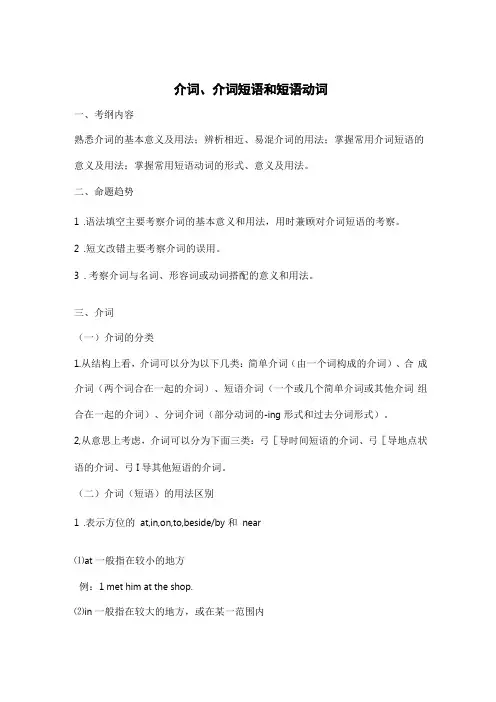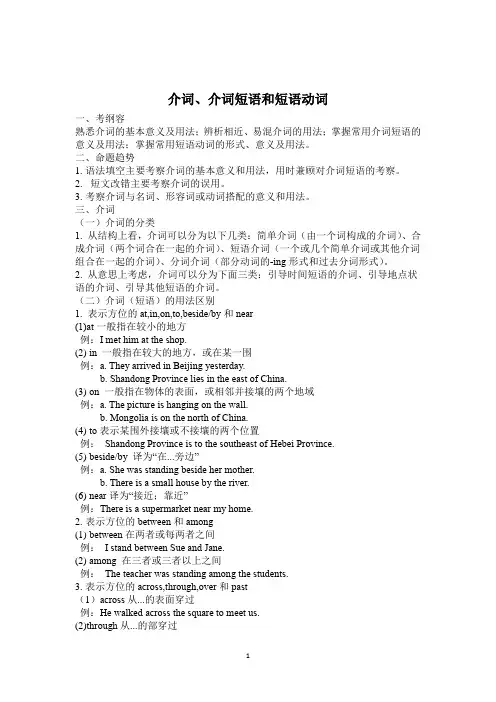专题二 介词、介词短语和动词短语.pptx
- 格式:ppt
- 大小:268.50 KB
- 文档页数:3






介词、介词短语和短语动词一、考纲内容熟悉介词的基本意义及用法;辨析相近、易混介词的用法;掌握常用介词短语的意义及用法;掌握常用短语动词的形式、意义及用法。
二、命题趋势1.语法填空主要考察介词的基本意义和用法,用时兼顾对介词短语的考察。
2.短文改错主要考察介词的误用。
3.考察介词与名词、形容词或动词搭配的意义和用法。
三、介词(一)介词的分类1.从结构上看,介词可以分为以下几类:简单介词(由一个词构成的介词)、合成介词(两个词合在一起的介词)、短语介词(一个或几个简单介词或其他介词组合在一起的介词)、分词介词(部分动词的-ing形式和过去分词形式)。
2,从意思上考虑,介词可以分为下面三类:弓[导时间短语的介词、弓[导地点状语的介词、弓I导其他短语的介词。
(二)介词(短语)的用法区别1.表示方位的at,in,on,to,beside/by 和near⑴at 一般指在较小的地方例:1 met him at the shop.⑵in 一般指在较大的地方,或在某一范围内例:a. They arrived in Beijing yesterday.b. Shandong Province lies in the east of China.⑶on 一般指在物体的表面,或相邻并接壤的两个地域例:a. The picture is hanging on the wall.b. Mongolia is on the north of China.(4)to表示某范围外接壤或不接壤的两个位置例:Shandong Province is to the southeast of Hebei Province.(5)beside/by译为“在…旁边”例:a. She was standing beside her mother.b. There is a small house by the river.(6)near译为“接近;靠近”例:There is a supermarket near my home.2.表示方位的between和among⑴between在两者或每两者之间例:I stand between Sue and Jane.⑵among在三者或三者以上之间例:The teacher was standing among the students.3.表示方位的across,through,over 和past(1)across从…的表面穿过例:He walked across the square to meet us.⑵through从…的内部穿过例:The guide led us through the forest.⑶over从…的上面跨过例:The thief jumped over the fence and fled away.(4)past在…的旁边经过例:She walked past the shop.4.表示时间的介词⑴表示“在…”的:at,in,ona.at表示在某个时间点、时刻或重大节日例:at 9:00; at noon; at Christmasb.in表示在某段较长的时间内,世纪、朝代或年月;泛指的上午、下午、傍晚等。

专题二-介词、介词短语和动词短语高考必备专题二介词、介词短语和动词短语知识清单on, about, of(1)表示“具有”“没有”的介词With, without(2)表示“原因”的介词Because of, due to, owing to, thanks to, on account of, as a result of, with, for, at, of (3)表示“代替”的介词Instead of, in place of二、常考介词短语1. 介词与名词的常用搭配(1)at+n.表示状态at a loss 不知所措at breakfast 早餐时at peace 处于和平中at rest 静止,不动at sea 在海上,航海at war 在战争中at work 在工作(2)at+n.表示时间at Chrismas 在圣诞节at dusk 在黄昏at dawn 在黎明at daybreak 在拂晓at midnight 在午夜at night 在夜里at noon 在正午at present 目前at sunrise 日出时(3)以at开头组成的短语at the beginning of 在……的开始at the cost of 以……的代价1.Addadd……to 把……加到……上面add to 增添add up to加起来总共add up把……加起来2.AgreeAgree on 就……达成共识Agree to 同意Agree with 同意,适合,和……一致3.BreakBreak away from 脱离,突然挣脱Break down 失败,被搞垮,分解,(机器或车辆等)出故障,坏掉Break into 强行闯入Break in on 打断,搅扰Break out 爆发Break up 解散Break off 停顿,中断Break through 突破4.BringBring about 引起,造成Bring down 使倒下;降低(价格)Bring in 赚得Bring on 引起,导致Bring sth on 促使(作物、水果等)生长Bring out阐明Bring up 抚养;呕吐Bring forward 提出Bring sth forward 将(……的日期或时间)提前5.CallCall for 需要;需求Call in on sb = drop in on sb,call in at sb =drop in at sb 顺便拜访某人Call in 找来,请来;召集Call off 取消Call upon 请/叫(某人做某事)Call on 号召Call out 喊,叫Call up 使想起某事物,使回忆起某物6.CareCare for 在意,关心;照顾,照料Would you care for sth = Would you like sth(礼貌用语)你喜欢/要……吗?Care about 关心,关怀7.CarryCarry on 进行;继续进行下去Carry out 完成;履行Carry sth through=complete sth successfully 顺利完成,顺利实现8.CatchCatch fire=start to burn 着火Catch one’s breath 恢复正常呼吸Catch one’s eye/attention 引起某人的注意Catch on= understand 理解Be caught in=be stuck in 被困住Get caught in=be hooked in 被钩住Catch sight of 看见Catch up with赶上9.CheckCheck in (在旅馆、机场等)登记Check in one’s luggage (托运)行李Check out 结账离开(旅馆等)eCome true 变成现实Come about 发生Come across (无意中)碰到,找到;被理解,被弄懂Come on 快点儿Come out 出版;开花;考试结果……,考第……名Come out with说出(尤指令人吃惊或粗鲁的话)When it comes to 谈到,涉及Sth/sb come to light 被发现,被大家知道Come up 被提及Come up with提出Come to oneself 苏醒过来Come to an end结束Come into effect/force开始生效Come to a conclusion/decision 得出结论/作出决定Come into being/existence 开始存在,成立,产生Come to power 开始执政11.CutCut sth off 切断,切下来Cut out (马达或发动机)突然熄火,停止运转;戒掉,不吃Cut up 切碎Cut down 砍倒Cut sth down 削减,减少Cut through 开辟(出路或通道)12.DieDie away/down(指风、声、光等)逐渐减弱,逐渐平息Die out 灭绝,不复存在Die for 极度渴望13.DoDo up 包,扎,系,捆;整理,收拾Do oneself up 梳妆打扮Do away with 废除Do harm to sb. 对……有害Do good to sb. 对……有好处Do without (sb./with)(尤与can或could 连用)不用或没有某人/某物也行Have something/nothing/a lot to do with 与……有些/没有/有很大关系14.EndEnd up with以……告终End up sth with sth 以……结束End up 最后(有某种结局/成了)End in 以……告终,结果是……15.FallFall behind 落后于Fall in love with 爱上,喜欢上Fall down 不能令人满意,不够好Fall into=be divided into 被分成Fall in with = agree with 赞同16.FixFix the date for约定……的日期Fix one’s attention on 注意17.GetGet back 回来,取回Get up 起床,起身Get sb through 给……接通电话Get through 用完;通过;做完Get round 消息传开Get along/on with (与某人)和睦相处Get away from 摆脱Get down to开始认真做某事Get over 克服,摆脱(某种情绪)Get rid of 摆脱,去掉Get in 收集或收获某物Get across 被理解;把……讲清楚Get away with it 侥幸逃脱18.GiveGive away 捐赠,赠送;泄露,暴露Give in to 勉强同意Give off 散发出Give out 分发。




介词、介词短语和短语动词一、考纲容熟悉介词的基本意义及用法;辨析相近、易混介词的用法;掌握常用介词短语的意义及用法;掌握常用短语动词的形式、意义及用法。
二、命题趋势1.语法填空主要考察介词的基本意义和用法,用时兼顾对介词短语的考察。
2.短文改错主要考察介词的误用。
3.考察介词与名词、形容词或动词搭配的意义和用法。
三、介词(一)介词的分类1. 从结构上看,介词可以分为以下几类:简单介词(由一个词构成的介词)、合成介词(两个词合在一起的介词)、短语介词(一个或几个简单介词或其他介词组合在一起的介词)、分词介词(部分动词的-ing形式和过去分词形式)。
2. 从意思上考虑,介词可以分为下面三类:引导时间短语的介词、引导地点状语的介词、引导其他短语的介词。
(二)介词(短语)的用法区别1. 表示方位的at,in,on,to,beside/by和near(1)at一般指在较小的地方例:I met him at the shop.(2)in 一般指在较大的地方,或在某一围例:a. They arrived in Beijing yesterday.b. Shandong Province lies in the east of China.(3)on 一般指在物体的表面,或相邻并接壤的两个地域例:a. The picture is hanging on the wall.b. Mongolia is on the north of China.(4)to表示某围外接壤或不接壤的两个位置例:Shandong Province is to the southeast of Hebei Province.(5)beside/by 译为“在...旁边”例:a. She was standing beside her mother.b. There is a small house by the river.(6)near译为“接近;靠近”例:There is a supermarket near my home.2.表示方位的between和among(1)between在两者或每两者之间例:I stand between Sue and Jane.(2)among 在三者或三者以上之间例:The teacher was standing among the students.3.表示方位的across,through,over和past(1)across从...的表面穿过例:He walked across the square to meet us.(2)through从...的部穿过例:The guide led us through the forest.(3)over从...的上面跨过例:The thief jumped over the fence and fled away.(4)past在...的旁边经过例:She walked past the shop.4.表示时间的介词(1)表示“在...”的:at,in,ona.at表示在某个时间点、时刻或重大节日例:at 9:00; at noon; at Christmasb. in表示在某段较长的时间,世纪、朝代或年月;泛指的上午、下午、傍晚等。